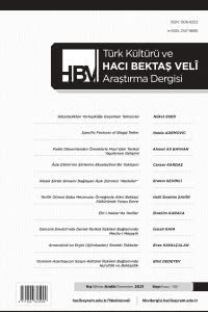KARGIN VE MEŞELİ'DE YER ALAN ALEVİ YAPILARI
Günümüzde Alevilik daha çok inanç, kültür veya siyaset odaklı çalışma konusu olmaktadır. Ancak özellikle inanç yönü ele alınırken ritüellerin gerçekleştiği mekânlar ilgili araştırmaların az sayıda olduğu görülmektedir. Bu çalışmalarda da Alevi dini yapılarının mimari tipolojilerinden çok bazı unsurları daha çok incelenmiştir. Oysaki Anadolu'nun değişik bölgelerinde yer alan ve farklı mimari özelliklerini barındıran Alevi dini yapılarının derli toplu bir halde incelenmesi ve literatüre kazandırılması gerekmektedir. Bu durum daha çok sözlü aktarıma dayanan Alevilik inancının anlaşılması ve yeni inşa edilen dini yapıların şekillenmesi için önem arz etmektedir. Bu nedenle yapılan bu çalışmada Kargın ve Meşeli (Ankara-Çubuk) yerleşim yerlerindeki iki ayrı yapı ele alınmıştır. Bu iki yapı hem farklı tarihli oldukları -mimari bir süreklilik arz ettikleri- hem de kırsal bölge mimarilerini yansıttıkları için örnek seçilmiştir. Çalışma esnasında söz konusu iki yapı mimari özellikleri ve bu özelliklerinin hem Bektaşi hem de Alevi dini yapıları ile olan ilişkisi bağlamında değerlendirilmiştir. Söz konusu iki yapının geleneksel mimariyi yansıttıkları, ortak planlara sahip oldukları ve ritüel odaklı şekillendikleri anlaşılmıştır.
THE STRUCTURES OF ALEVİ IN KARGIN AND MEŞELİ
Today Alevism is study subject more about working with faith, culture and politics. When the direction of faith is taken into consideration, apart from a certain number of researches and studies, there is little to be studied about the religious structures of Alevi. In these studies, some elements of the religious structures of Alevi were examined more than the architectural typologies. On the other hand, it is necessary to examine the religious structures of Alevi which is located in different regions of Anatolia and which has different architectural features, and to gain literature. This is more important for understanding the belief of Alevism based on verbal communication and for shaping newly built the religious structures. For this reason, two different places of worship in Kargın and Meseli (Ankara-Çubuk) settlements were handled in this study. These two structures have been chosen as examples because they are both of different dates - they are a material continuity - and they reflect the architectures of rural areas. Within the context of the study, these two architectural features were examined one by one. Again, the architectural characteristics of these constructions are evaluated in relation to both the religious structures of Bektashi and Alevi. It is understood that these two structures reflect the traditional architecture, have common plans and are shaped with ritual focus.
